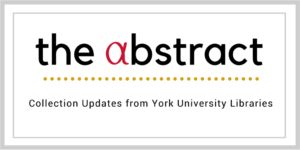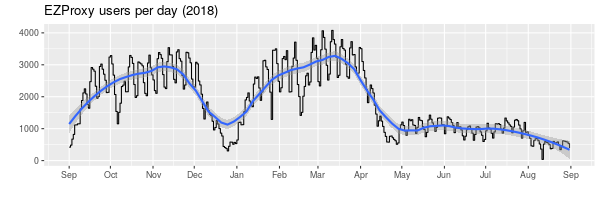Collections Updates from York University Libraries
The Abstract
Volume 3, Issue 1 | November 2019
This work is licensed under a Creative Commons Attribution 4.0 International License.
CONTENTS:
An Introductory Note
By: PATTI RYAN
Director, Content Development and Analysis
I am pleased to introduce the Fall edition of The Abstract, brought to you by the Content Development & Analysis (CDA) Department at York University Libraries. This publication is designed to highlight new or unique collections made available through the Libraries, and keep the York community up to date on collections-related activities that directly support teaching, learning and research on the campus.
CDA members work together to ensure that York students and faculty have broad and seamless access to the scholarly content made available through the Libraries. As part of our new organizational design, introduced July 1, 2018, CDA brings together a cross-disciplinary team of seven librarians with our dedicated and talented acquisitions team. Our acquisitions team, pictured below, operate mostly “behind the scenes” to ensure that the materials you need for research and teaching are ordered, processed and paid for in a timely way. So, the next time you check out a book, pull a bound journal from a shelf, or access our vast collection of electronic resources, you can thank one of these friendly faces!
From left to right: Adriana Bugyiova, Samdai Mahadeo-Bidhesi, Savka Marijan, Rubina Shahjahan, Alison Ball, Teresa Pujdak, Myrtle Hutchinson, and Sandra Bratovic.
Artists' Books Collections
By: MARY KANDIUK
Content Development Librarian
York University Libraries continues to build on the extensive collection of nearly 700 artists’ books that were acquired by Clara Thomas Archives and Special Collections as part of the Granary Artists’ Books Collection in 2011. Now exceeding 2,000 titles, the collection includes unique and limited editions and books produced in multiple editions by artists or artist collectives. Both independent and mainstream presses and works that are self-published are collected. Also represented in the collection are works that reflect collaborations between illustrators, designers, typographers, book binders, printers, visual artists, poets and writers. The collection is international in scope with an emphasis on the 1960s to the present and a focus on Canadian artists.
Highlights of Recent Acquisitions
The artist’s book in Quebec has its roots in and is closely associated with the livre d’artiste movement in Europe. The tradition of the livre d’artiste permeated early private presses in Quebec and the strong emphasis on printmaking. Several of our recent artists’ books acquisitions fall into this category. These include works by Gaston Miron, Claude Gauvreau, Claude Haeffely, and Gilles Hénault that were published by poet, painter and engraver Roland Giguère, who founded Éditions Erta in 1949.
We’ve developed a wonderful working relationship with artist bookmaker Marlene MacCallum now located in Prince Edward County, formerly from Memorial University where she taught printmaking, photography and book arts. We have acquired all of her works and have hosted her in Archives & Special Collections where she gave a talk on her artist bookmaking to AMPD students in upper level printmaking. Her latest work, Shadow – Canto Two: Graffiti, received the ABE Artist’s Book Award in conjunction with the Art of the Book 2018.
Other contemporary recent acquisitions include works by Guylaine Couture, Tara Bryan, Lise Melhorne-Boe and Cathryn Miller. Guylaine Couture, who lives and works in Montreal, is “obsessed by the reuse of printed documents, by the preservation of the forgotten zone of a photo and by the recycling of material having already lived.” Guylaine Couture’s subjects include cancer, ecology, mourning and landscape. We have recently acquired the titles I Saw You and Alonely. Tara Bryan is a painter and book artist, living and working on the edge of the North Atlantic in Newfoundland. Her work Down the Rabbit Hole is an example of a tunnel book. We’ve strengthened our holdings of works by Lise Melhorn-Boe, originally from Noranda, Quebec, now living in Kingston, Ontario. Lise Melhorn-Boe is “drawn to women’s experiences in the political and personal spheres” using “humour and a light-hearted visual aesthetic to explore more serious feminist and environmental issues.” We’ve also acquired two titles by Cathryn Miller, Political Promises and Affluenza, a former theatrical designer and fibre artist turned paper-maker, residing in Grasswood, Saskatchewan where she runs Byopia Press.
EZProxy and Electronic Resource Use
By: WILLIAM DENTON
Scholarly Analytics Librarian
York University Libraries spends most of its collections budget on online resources: each of the last two years we’ve spent about $10 million on journals (individually or in big clusters like at JSTOR), e-books, data sources (such as the OECD i-Library), specialized reporting and analysis (like Passport for business), music, movies, and more. When you visit one of these sites on campus, using AirYorkPLUS or a wired computer in a lab, the site knows you're from York and lets you use it.
What about when you're off campus? How does the site know you're a York person and are allowed access? You don't want to see that warning: "You do not have access to this article. Click here to purchase it for $38." You want to be able to get access to everything we have from wherever you are. (If you ever do see that warning, ask us! You should never pay for an article. We can help you get it for free, legally and properly.)
We make the access work by using a "proxy server" in this case EZProxy. (It's American, so it's pronounced "easy proxy;" saying "ee-zed proxy" never caught on in Canada.)
Instead of going directly to JSTOR, your browser hits our web server first, and tells EZProxy "I want to go to JSTOR." EZProxy asks you to log in with your Passport York account, to prove you're a York person, and then acts as a gateway back and forth between you and JSTOR. When you want to do a search on JSTOR, EZProxy passes your request through; JSTOR knows the request is coming from York, therefore it gives an answer, and it sends the results back to EZProxy, which passes them on to you.
Our EZProxy server is very busy. At the end of October, on a busy day it's processing about 750,000 requests per day. But that doesn't mean 750,000 people are using it. When you're off campus and using an online resource, every single thing on all those web pages goes through EZProxy, including all the images and the small files that help control how the site looks and how you interact with it. The numbers for the actual stuff you're after, like PDFs, is much lower.
EZProxy helps us understand how people use online resources. Because York is such a commuter campus, most people do most of their research while they're not here, which means they're going through EZProxy. We think the ratio of off-campus use to on-campus use is about 3:1, so EZProxy gives us some very useful measures of activity.
Some of the results are shown on the YUL Dashboard. At time of writing about 30,000 different people have used EZProxy at least once. This number will be over 50,000 by next summer. And the "EZProxy users per day" chart shows just that: you can see the weekly pattern where Fridays and Saturdays are slow, then on Sundays people are back to work. (You can see how things really slowed down over the Thanksgiving holiday, too.)
Below is a chart showing users of EZProxy last year. In the busy times for assignments during the fall and winter terms, on average 3,000 people used it each day, peaking to 4,000. This means probably about 4,000 people are doing research on a given day either on campus or off, peaking to over 5,000. Over the summer term usage is pretty steady at about 1,000 people per day. In the next issue we’ll cover more about the YUL Dashboard, and also about how we use EZProxy to help manage our online resources.
(If you’re interested in the code that makes the dashboard work, see the source code on GitHub. We believe in free and open software, and open access to all of our work!)
Recent Acquisitions in the Archives and Special Collections
By: KATRINA COHEN-PALACIOS
Archivist
The following archival records have recently been processed, described, and are now available for public access!
-
-
- The records of Rockette and USO troupe dancer Jeannette Heller.
- The videotaped performances of folk musicians by Jonathan Lynn.
- The documents of the Canadian Science and Technology Historical Association.
- The records of the Canadian Society for the History and Philosophy of Science.
- The files of the Canadian Association for Latin American and Caribbean Studies.
-
New material has also been added to the Home Made Visible and York University Archives ephemera collections, in addition to the fonds of poet Karen Connelly, Professor Robert J. Drummond, television executive Brian Freeman, film director Bruce Pittman, playwright and script writer Jason Sherman, Professor Emeritus John Warkentin, and literary magazine Waves.
Previous Issue: Volume 2, Issue 3 | July 2019





